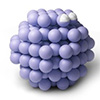| Feb 17, 2025 |
|
|
|
(Nanowerk News) All humans need clean water to live. However, purifying water can be energy-intensive, so there is great interest in improving this process. Researchers at Tohoku University have reported a strategy using data-driven predictions coupled with precise synthesis to accelerate the development of single-atom catalysts (SACs) for more robust and efficient water purification.
|
|
SACs are one of the most crucial catalysts. They play a pivotal role in enhancing efficiency in diverse applications including chemical industries, energy conversion, and environmental processes. For water purification in particular, SACs can overcome the limitations of traditional heterogeneous catalysts such as the kinetics, catalytic selectivity, and stability – paving a promising way for the advancement of efficient and sustainable water purification technologies.
|
|
However, the development of SACs frequently employs time-consuming trial-and-error methods, and the typical synthesis methods often lack a high level of control. To avoid a process that essentially involves taking shots in the dark, researchers took a data-driven approach where they rapidly and accurately predicted which SACs would have the best performance before even starting to make them. They compared 43 metals-N4 structures comprising transition and main group metal elements using a hard-template method.
|
|
Following this strategy, they determined that the best candidate was a well-designed Fe-SAC with a high loading of Fe-pyridine-N4 sites (~3.83 wt%) and highly mesoporous structure. It successfully exhibited ultra-high decontamination performance (rate constant of 100.97 min-1 g-2).
|
|
“The optimized Fe-SAC can also continuously operate for 100 hours,” remarks Associate Professor Hao Li of WPI-AIMR, “To our knowledge, this represents one of the best performances of wastewater purification on Fenton-like catalysts – which are reagents used for water purification – reported so far.”
|
 |
| (a) Schematic illustration of the synthesis of M-SACs. (b) Proposed schematic of the density of Fe-N4 sites in Fe-SAC, which were prepared by using the different concentrations of FeCl3. (c) Comparison of the Fe loadings of as-prepared Fe-SACs. (d) Proposed schematic of pore structures in Fe-SAC, which were prepared by using the different concentrations of SiO2 hard template. (e) Comparison of the pore structure parameters of Fe-SAC-1 and Fe-SAC-4. (f) TEM, (g) Aberration-corrected HAADF-STEM and (h) EDS mapping images of Fe-SAC-4. (i) EXAFS spectra at Fe K-edge. (j) N K-edge XANES spectra of as-prepared Fe-SACs. (k) Fitting results of the EXAFS spectra of Fe-SAC-4 at R space. Inset: schematic model of Fe-SAC-4. (l) WT of the Fe K-edge of Fe-foil and SAC-4. (Image: Hao Li et al.)
|
|
Density functional theory calculations revealed that the underlying mechanism was that the SAC reduced the energy barrier of the rate-determining step, which is intermediate O* formation. This resulted in the highly selective generation of singlet oxygen, which has been shown to break down pollutants to help purify water.
|
|
To make sure the data-driven prediction had accurately selected this “best” candidate, the research team looked at five other metals-N4 structures (i.e., Fe, Co, Ni, Cu, and Mn) with different theoretical activities. They confirmed that Fe-SAC truly exhibited the most excellent Fenton-like performance among the five selected SACs, agreeing well with the data-driven prediction.
|
|
The close integration of a data-driven method with a precise synthesis strategy provides a novel paradigm for the rapid development of high-performance catalysts for environmental fields, and other fields that involve sustainable energy and catalysis. Moving forward, they aim to develop an efficient and user-friendly workflow for the rapid and effective design of catalysts.
|
|
Those interested in incorporating the method into their own work can view the experimental data and computational structures in the Digital Catalysis Platform (DigCat): the largest experimental catalysis database reported to date, developed by the Hao Li Lab. The findings were also published in Angewandte Chemie International Edition (“Driven Accelerated Discovery Coupled with Precise Synthesis of Single-Atom Catalysts for Robust and Efficient Water Purification”).
|


